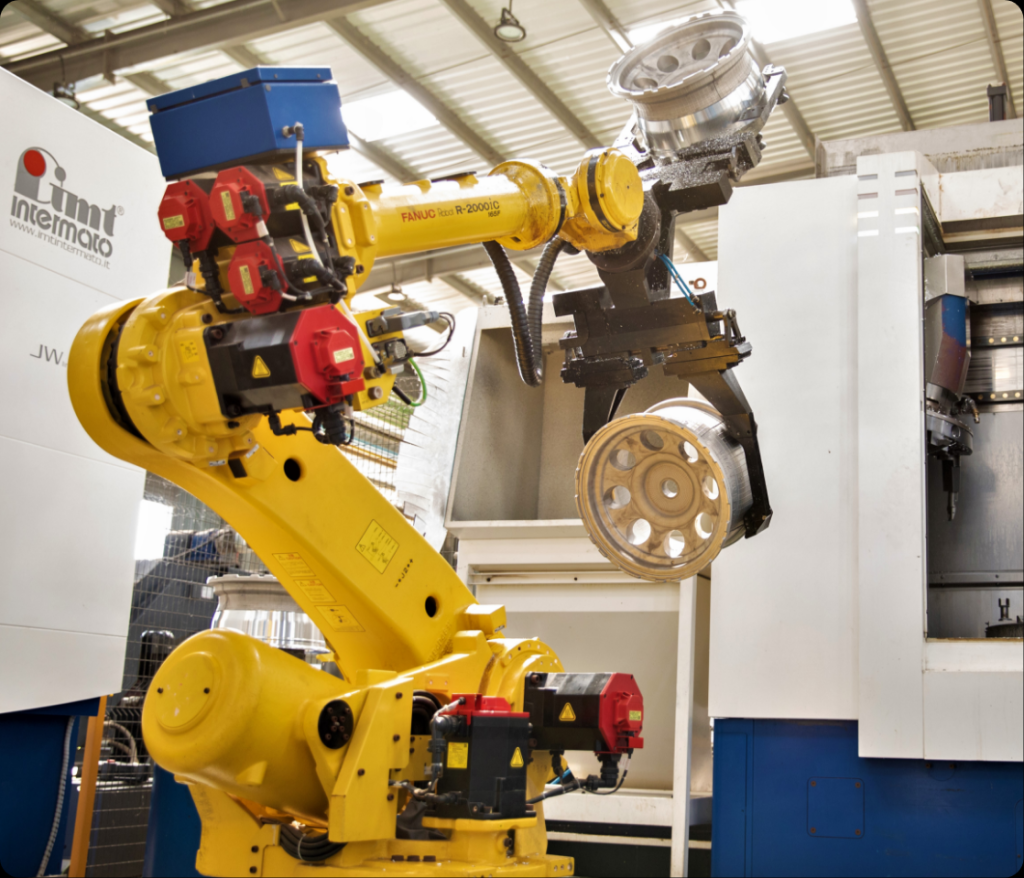Precision mechanical parts: the core cornerstone of the development of the robotics industry
As the wave of Industry 4.0 sweeps the globe, robots have evolved from repetitive laborers on traditional production lines to precision operators in fields such as healthcare, aerospace, and high-end manufacturing. This remarkable development is inseparable from the continuous breakthroughs in precision mechanical component technology. As the "skeleton" and "joints" of robots, the accuracy, stability, and reliability of precision mechanical components directly determine the robot's operational capabilities, motion accuracy, and service life. Together, these components form the core foundation of modern intelligent manufacturing systems.
Core precision parts: the "key organs" for robots to achieve high-precision movement
Every precise movement of the robot relies on the coordinated work of multiple core precision mechanical components. These components are like the joints, muscles, and nerves of the human body, converting electrical energy or hydraulic energy into precise mechanical motion through micrometer or even nanometer-level cooperation. The most representative ones include precision gears, ball screws, harmonic reducers, and precision bearings.
Precision gears are the core hub of robot power transmission. In the joint drive systems of industrial robots, high-precision helical gears and planetary gear sets must achieve backlash-free transmission, with tooth surface roughness controlled below Ra0.4μm and a pitch error of no more than ±3μm. This ultra-high-precision design effectively minimizes energy loss and vibration during power transmission, ensuring the stability of the robot arm even at high speeds. For example, the precision gear sets used in ABB's IRB 6700 series industrial robots utilize carburizing, quenching, and ultra-precision grinding processes to increase gear transmission efficiency to over 98%. This allows for a load capacity of 150kg while maintaining a repeatability of ±0.05mm.
Ball screws are the "precision guides" for robotic linear motion. In the linear axes of Cartesian robots or CNC machining centers, ball screws convert rotational motion into linear motion through rolling friction between the steel balls, the screw, and the nut. They offer positioning accuracy of ±0.01mm/1m and a backlash of less than 0.005mm. Compared to traditional sliding screws, ball screws have a friction coefficient of only 0.001-0.003, significantly reducing energy consumption and preventing precision drift caused by frictional heat. Precision ball screws manufactured by Japan's THK Corporation are widely used in Tesla's Model 3 body welding robots, helping them achieve a high production rate of 60 vehicles per hour.
The harmonic reducer is known as the "precision heart" of robot joints. As a core component of industrial robots and collaborative robots, the harmonic reducer achieves speed reduction through the elastic deformation of flexible gears, with a transmission ratio ranging from 50 to 500, while its size is only 1/3 of that of traditional planetary reducers. More importantly, the return error of the harmonic reducer can be controlled within 1 arc minute (approximately 0.0167 degrees), allowing robots to make "millimeter-level" adjustments during delicate tasks like assembly and polishing. For example, the harmonic reducer used in the FANUC CRX series collaborative robots features a special tooth shape design and material process, ensuring that after continuous operation for 10,000 hours, the accuracy degradation does not exceed 5%, meeting the stringent requirements for long-term stability in medical surgical robots.
Furthermore, precision bearings also play an irreplaceable role as the "support framework" for the robot's rotating components. Crossed roller bearings, commonly used in robot joints, utilize a cross-arrangement of rollers and inner and outer rings to simultaneously withstand radial, axial, and tilting moments, with radial runout controlled to below 5μm. This structural design prevents the robot arm from shifting under load, ensuring stable repeatable positioning accuracy. In semiconductor wafer handling robots, the use of precision crossed roller bearings ensures a positioning error of no more than ±0.002mm when handling 300mm diameter wafers, preventing scratches and damage to the wafer surface.
Precision and reliability: Precision parts define the robot's "operating limit"
The performance requirements for precision mechanical parts in robotics vary significantly across different application scenarios, but high precision and reliability remain core priorities. These requirements are reflected not only in the initial accuracy of the parts but also in their stability and resistance to wear and tear during long-term operation. These demands are driven by breakthroughs in material processing, machining techniques, and testing methods.
In the field of medical robotics, component precision and biocompatibility are directly linked to surgical safety. For example, the positioning accuracy of the end effector of an orthopedic surgical robot must reach ±0.1mm. This requires that the precision gears and lead screws within the robot be made of non-magnetic materials (such as titanium alloy) and undergo ultra-precision electrochemical machining (UPEM) to achieve a mirror-like surface roughness of less than Ra0.1μm. Furthermore, component sealing must meet IP67 protection levels to prevent corrosion caused by the intrusion of blood and bodily fluids. The orthopedic surgical robot from the German company Zimmer Biomet achieves zero contamination during surgery by utilizing ceramic-coated precision bearings and a specialized sealing structure. Its components are designed for a lifespan of over 100,000 surgeries.
In the aerospace field, the extreme environments robots face (high and low temperatures, and vacuum) place higher demands on the weather resistance of precision components. Precision hinges in satellite deployment mechanisms must maintain motion accuracy through temperature cycles ranging from -180°C to 150°C. They are made from a combination of titanium alloy and carbon fiber composite materials, and undergo low-temperature aging to eliminate internal stress. The gap between the hinge components of the satellite solar wing deployment robot developed by the China Aerospace Science and Technology Corporation is controlled to within 2μm, ensuring precise deployment and locking of the solar wing in space, with an error of no more than 0.5 degrees.
In industrial manufacturing, the high-load, continuous operation characteristics of robots require precision parts to possess extremely strong fatigue resistance. The joint reducers of automotive welding robots must withstand tens of thousands of starts and stops and load fluctuations daily. Therefore, their gears must be made of high-strength carburized steel (such as 20CrMnTi), with the tooth surface hardness increased to over HRC60 through laser surface alloying. According to statistics, precision gears produced using this process can achieve a fatigue life of up to 15,000 hours, an increase of over 50% compared to traditional methods, effectively reducing equipment maintenance costs in automotive factories.
Collaborative development: "two-way empowerment" of precision parts technology and the robotics industry
The relationship between precision mechanical parts and the robotics industry is not a one-way "support" but a two-way "empowerment" - the upgrading of demand in the robotics industry is driving the development of precision parts technology towards higher precision, lighter weight and more intelligent directions; and breakthroughs in precision parts technology have provided the possibility for robots to expand new application scenarios, forming a virtuous circle of "demand driving technology, and technology opening up the market."
On one hand, the demand for "miniaturization" and "lightweight" of robots is forcing precision components to transform towards "micro-sizing" and "integration". With the popularity of collaborative robots and micro-robots in electronic manufacturing and medical fields, traditional precision components can no longer meet the requirements of "small space and low weight". For example, the joints of micro-robots used for smartphone screen bonding need to be controlled to a diameter of less than 10mm, which requires the volume of harmonic reducers to be reduced to 1/5 of that of traditional products, while maintaining the same transmission accuracy. To this end, Japan's Harmonic Drive company has developed a "micro harmonic reducer" that reduces the diameter of the reducer to 8mm and weighs only 2g by adopting powder metallurgy processes and integrated flexible gear design, clearing obstacles for the development of micro-robots.
On the other hand, the "intelligent" upgrade of precision components has endowed robots with capabilities of "state perception" and "predictive maintenance." Traditional precision components only serve as movement execution parts and cannot provide feedback on their operating status, while modern precision components can integrate sensors (such as temperature sensors and vibration sensors) to monitor the temperature, vibration, and wear levels of the components in real time, transmitting the data to the robot control system. For example, the "intelligent ball screw" launched by Schaeffler Group can monitor the operating temperature and vibration frequency of the screw in real time by embedding RFID chips and vibration sensors inside the nut. When abnormalities are detected, the robot can automatically adjust the operating parameters or issue maintenance warnings, avoiding production line shutdowns caused by component failures.
From industrial robots' precision welding to medical robots' minimally invasive surgery, from aerospace robots' space assembly to consumer electronics robots' precision bonding, precision mechanical parts have always been the core foundation for robots to achieve operational capabilities that "surpass human limits." In the future era of intelligent manufacturing, with continuous breakthroughs in precision parts technology and the continued expansion of robotic application scenarios, the two will continue to deeply integrate, jointly writing a new chapter in the transformation of human production and lifestyle.

![]()


